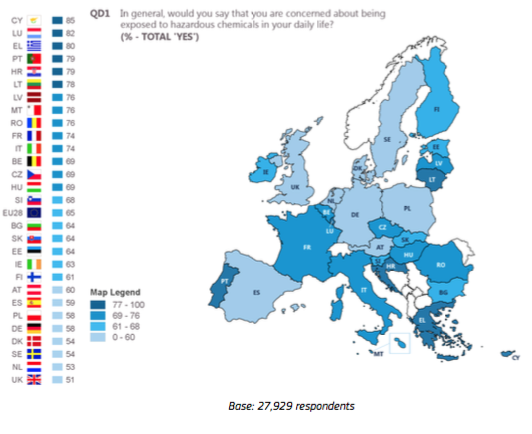Baltic countries are concerned about chemical safety
 European Commission has recently released newest “Eurobarometer” survey about chemical safety. Survey was released last month. It analyses public awareness and information about chemicals, public perceptions about safety of chemicals and who is and should be responsive, also – awareness and understanding of chemical hazard pictograms. Survey was held in 28 different European Union countries. People from different social and demographic categories were interviewed. Inhabitants of Lithuania, Latvia and Estonia were surveyed too. Each country had around 1000 respondents.
European Commission has recently released newest “Eurobarometer” survey about chemical safety. Survey was released last month. It analyses public awareness and information about chemicals, public perceptions about safety of chemicals and who is and should be responsive, also – awareness and understanding of chemical hazard pictograms. Survey was held in 28 different European Union countries. People from different social and demographic categories were interviewed. Inhabitants of Lithuania, Latvia and Estonia were surveyed too. Each country had around 1000 respondents.
One of the most significant regulatory measures governing the use of chemicals in the EU, is the Registration, Evaluation and Authorisation of and Restriction Chemicals (REACH) Regulation. REACH places high responsibility for chemicals management on industry and leads to a greater awareness about hazardous substances. Project “LIFE fit for REACH”, which takes place in all three Baltic countries: Lithuania, Latvia and Estonia, focuses on downsizing the levels of chemicals on the level of emitters – small or medium companies. But public awareness about chemicals is also very important in the process of change.
Less informed – more concerned
One of the main results of the survey – the majority of EU inhabitants are concerned about being exposed to hazardous chemicals. 65 % said they are at least a little concerned. Lithuanians are one of the most concerned (78 %), Latvians are also not too far behind (76 %). Estonians are close to average answers (64 %).
The survey showed, that less than half of respondents feel well informed about the potential dangers of the chemicals contained in consumer products. Estonia is one of the countries where more people feel well informed. Inhabitants of other Baltic countries usually feel like being in the middle – knowing something, but not too much.
The survey shows that if people feel more informed they seem to be less concerned about the dangers considering hazardous chemicals.
People do not trust public authorities
“Eurobarometer” survey displays that the main sources where people get information about chemicals from are product labels (70 %) and media (53 %). So it shows that media should be more involved in spreading useful information to inhabitants.
Estonia is the leader with people who mostly read product labels and needed information about dangerous substances from there (83 %). Lithuania’s most trusted source is media. But also they trust family, friends and relatives a lot. It seems like Baltic countries are more trustful when information comes from people they know. In general the least trusted sources in all countries are public authorities.
Respondents trust EU products more than those that were imported. Estonians, Lithuanians and Latvians are less trustful. Less percent of survey participants think that products made in EU are safe so they are concerned about the danger of these products too, not only the ones coming from not EU countries.
As people are concerned about hazardous chemicals, about 50 % of respondents think, that level of regulation should be increased. Although almost half think that it has already increased a bit in last 10-15 years. Surveyed people are not sure who should be responsible for the level of safety – the majority chose the answer that the responsibility depends on many factors: EU authorities, national authorities, manufacturers etc.
Not all the pictograms are recognized
The respondents were also asked about four chemical hazard pictograms. The pictograms were also showed to them. People were asked not only if they recognize the pictograms but if they know the meaning they hold.
It appears, that the most recognizable pictogram is the “flammability” sign. While only 20 % said they have seen the respiratory health hazard pictogram. Although 63 % say they have seen the “exclamation mark” pictogram, but only 17 % could name the meaning of it. Many say that it stands for “environmental hazard”, although the real meaning is “skin irritant”. Estonians are the ones that know the “exclamation mark” pictogram the most.
Lithuania, Latvia and Estonia are below average in this situation. Only 11-12 % of respondents seem to have seen all four hazard pictograms before.
In general, respondents in the northern part of Europe are more likely to know the correct meaning of the pictogram than those in southern Europe.
According to the survey, most people after seeing chemical hazard pictogram read the safety instructions (76 %), but only 19 % read them not only on the label, but try to find further information.
Prepared by: Special Eurobarometer 456 Report. Chemical safety.